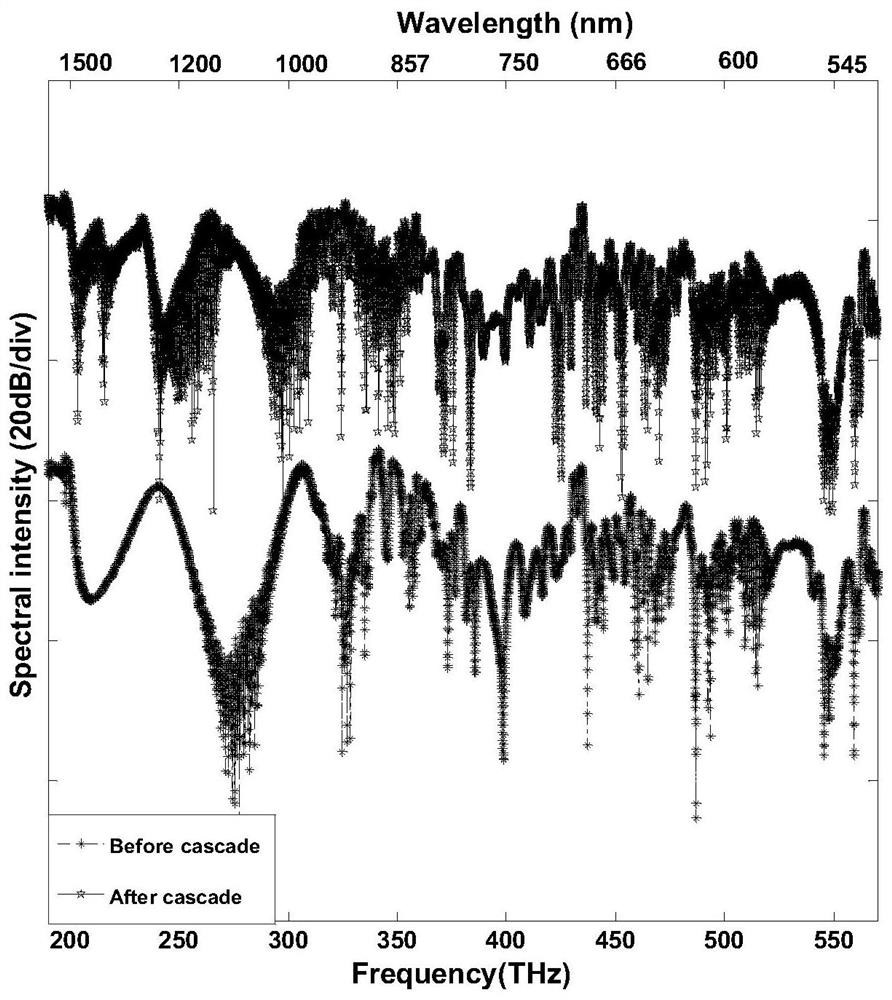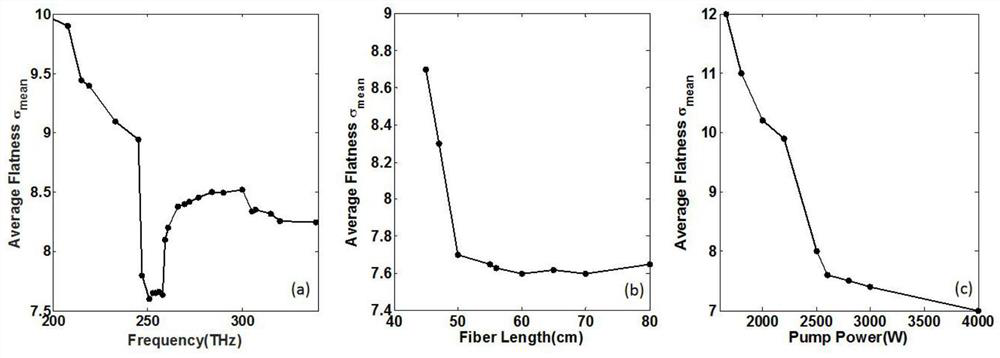Method for shaping super-continuum spectrum by using cascaded optical fibers
A technology of supercontinuum and optical fiber, which is applied in the field of shaping ultra-wideband supercontinuum, can solve the problems that the spectral width and flatness of supercontinuum are difficult to meet at the same time, and the limitation of supercontinuum, so as to improve flatness, improve power, Realize the effect of spectral flatness and spectral width
- Summary
- Abstract
- Description
- Claims
- Application Information
AI Technical Summary
Problems solved by technology
Method used
Image
Examples
Embodiment 1
[0014] A titanium sapphire laser source, the pulse of which is a femtosecond pulse, and the output wavelength is 795nm under the condition of 25°C. Use it as a pump light source, control its water cooling temperature at 25°C, and adjust its output power to 2600W. Its central wavelength (795nm, 375THz) is located in the anomalous dispersion region of the first-stage optical fiber.
[0015] figure 1 (a) is the experimental setup for cascading optical fibers to shape the supercontinuum, figure 1 (b) Schematic diagram of the experimental setup for supercontinuum generation from a single single-mode fiber. Two single-mode optical fibers (fiber 1 and optical fiber 2) were fused into a cascaded single-mode optical fiber through a fusion tapered machine with low loss, and the above-mentioned laser light sources were respectively injected into a section of 60 cm long cascaded optical fiber through the coupling system (No. First level: 40cm optical fiber 1, second level: 20cm optical...
Embodiment 2
[0019] Different from Example 1:
[0020] image 3 (a) Adjust the position of the second zero-dispersion frequency point (low-frequency zero-dispersion point) of the second-level optical fiber by adjusting the air aperture of the optical fiber and the size of the hole spacing, so that the flatness of the output spectrum increases with the zero-dispersion position change to change. The experimental results show that the best spectral flatness is 7.6 at the low-frequency zero-dispersion point of 251THz, which is the second zero-dispersion frequency of the second-stage optical fiber, which is located in the first fundamental frequency generated in the first section of cascaded optical fiber. When the first-order soliton is within the spectrum range of its fiber output end, the red-shifted soliton and the corresponding dispersion wave in the second-stage fiber can well fill the spectrum vacancy of the first-stage fiber at its output and improve the flatness of the spectrum. sex....
Embodiment 3
[0023] Different from Example 1:
[0024] image 3 (b) By changing the length of the second-level optical fiber, when the length of the second-level optical fiber is 20cm (wherein the length of the first-level optical fiber is 40cm), the flatness of the spectrum reaches the optimum of 7.6, and when the length of the optical fiber continues to increase, the output The flatness of the spectrum will not be significantly improved, but the transmission loss will be increased.
[0025]Experiments have found that as the length of the second-stage optical fiber increases, the flatness of the spectrum will be significantly improved and finally stabilized, so the appropriate fiber length can be selected according to needs to ensure good flatness and relatively small transmission loss.
PUM
| Property | Measurement | Unit |
|---|---|---|
| length | aaaaa | aaaaa |
Abstract
Description
Claims
Application Information
 Login to View More
Login to View More - R&D
- Intellectual Property
- Life Sciences
- Materials
- Tech Scout
- Unparalleled Data Quality
- Higher Quality Content
- 60% Fewer Hallucinations
Browse by: Latest US Patents, China's latest patents, Technical Efficacy Thesaurus, Application Domain, Technology Topic, Popular Technical Reports.
© 2025 PatSnap. All rights reserved.Legal|Privacy policy|Modern Slavery Act Transparency Statement|Sitemap|About US| Contact US: help@patsnap.com



